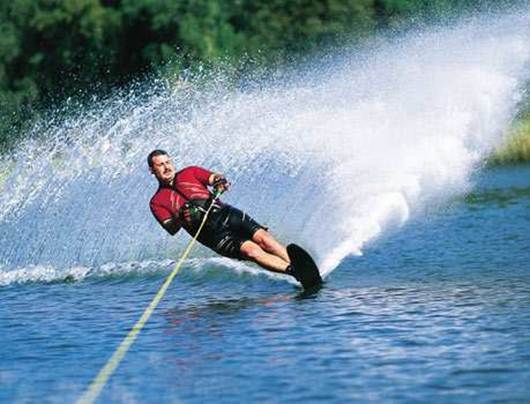Outdoor swimming
Cold swimming can help reduce blood
pressure and cholesterol

There is nothing like that first dip in a
glistening hotel pool. Refreshing and revitalising, swimming can be pretty
body transforming, too- even doggy- paddle can burn over 200 cals an hour. But
if you soon drift into ‘laday swimming’ in the quest to keep your hair dry, the
only muscles you will work out are the ones in your neck as you strain to keep
your head above the water. Tweak your technique and you will have had a total-
body workout all before the sunlounger scavenge begins (and be able to move
faster than that kid on the lilo, too).
Just breathe
Find you have enough puff to run 10k no
problem, but struggle after just three laps in the water? It sounds like you
are panting instead of breathing. ‘It is instinctive to hold your breath
underwater, then gulp for air when you come up. But that is not brathing, it is
hyperventilating!’ says instructor Steven Shaw (artofswimming.com). ‘Blow out
of your nose when underwater, then breathe in slowly when your face reaches
above the surface.’
Move your hips
Lifting your head during the front crawl is
like putting on your body’s brakes, slowing you down, tiring you our and
straining your back in one fell swoop. ‘To come up for a breath, rotate your
hips and shoulders to one side instead of just turning your head. Your face
will follow, meaning you can breathe without any danger of straining your
spine,’ says Steven.
Swithch it up
‘Swimming one stroke for your entire
session is like using one piece of equipment at the gym- you would not do it
because it is boring and inefficient,’ says Steven. Breaststroke tones your
legs and abs, while front crawl works your upper body, so mix them up for a
total- body workout.
Rollerblading
Rollerblading burns a whopping 700
calories an hour

LA, Miami, Bondi …beachside boardwalks are
full of impossibly cool, tanned girls whizzing around on a set of wheels like
they were born wearing them. Fancy finding out if those skills you picked up at
the roller disco are still Starlight Express- worthy? The good news is you do
not need the grace of a dancer or the balance of a tightrope walker to pull it
off graze- free.
Stay stable
Unless you have got the equilibrium of a
seasoned skier or a veteran yogi, you may find staying upright the biggest
chaleenge. Do not fall into the newbie trap of letting your head travel faster
than your body. ‘Your shoulders, knees and toes should all be in a vertical
line. If any part of you is out of line, you are asking for a fall,’ says
instructor Mike van Erp from London Skaters (londonskaters.com)
Push it
You will naturally want to push through
your toes or let your feet slice backwards and forwards, but try to push
sideways through your heels, instead,’ advises Mike. ‘Your strides should go
out to the side towards the 3 and 9 o’clock positions. To get into a rhythm,
think of your body like a metronome, tick- tocking from left to right.’
Location, location, location
Take a long, hard look at the pavement
before you even think of lacing up. Finding a flat, smooth place to skate is
really important- even the best skaters can be taken out by a rogue pavement
slab. Look out for sticks, stones, kerbs and even slight slopes so you can
svoid them at all costs,’ warns Mike.
Water- skiing
Water- skiing forces you to engage
your core muscles. Ab Fab!

Few things get your blood rishing like
cruising behind a speedboat in the Med, hair blowing in the wind. Admittedly,
this adrenaline- pumping, total- body workout takes a bit of practice, but is
so much fun that once you have got the hang of it, your friends will have to
physically drag you out of the water. Follow these first- timer tips to avoid a
face- plant:
Slowly does it
‘Do not try to stand up too quickly. As the
boat starts to pull away, you will be tampted to shoot up, but fight this
urge,’ advises John Battleday, instructor and owner of IBSki (ibski.com). ‘Let
your shoulders roll for ward and lift your bum, keeping your arms straight and
your knees bent. Once you find your balance in this crouched position,
straighten your legs inch by inch until you are finally upright.’
Do not do all the work
The boat is a lot stronger than you, so let
it do the heavy lifting. ‘A lot of first- timers try to pull themselves up, but
this just launches them forwards into a belly flop. Not cool. Keep your arms
locked and straight and let the boat pull you up,’ says John. And do not bend
your arms or tug on the rope!
Keep your eyes on the prize
Once you are up, stay there bu focusing on
the driver of the boat. ‘I always say, if you look down, you fall down. Keep
your head up and your eyes ahead,’ advises John.